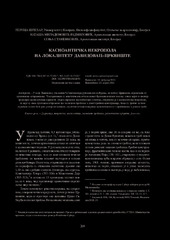Приказ основних података о документу
Kasnoantička nekropola na lokalitetu Davidovac-Crkvište
Late antique necropolis in Davidovac-Crkvište
| dc.creator | Špehar, Perica | |
| dc.creator | Miladinović-Radmilović, Nataša | |
| dc.creator | Stamenković, Sonja | |
| dc.date.accessioned | 2022-05-10T11:22:25Z | |
| dc.date.available | 2022-05-10T11:22:25Z | |
| dc.date.issued | 2013 | |
| dc.identifier.issn | 0350-0241 | |
| dc.identifier.uri | http://rai.ai.ac.rs/handle/123456789/187 | |
| dc.description.abstract | U selu Davidovcu, udaljenom 9,5 kilometara jugozapadno od Vranja, na potesu Crkvište, sprovedena su arheološka istraživanja. Tom prilikom su konstatovani ostaci manjeg bronzanodopskog naselja, iznad kojeg se kasnije formirao kasnoantički horizont. Pored skromnih naseobinskih ostataka, otkrivena je i kasnoantička nekropola, od koje su ovom prilikom istražene dve zasvedene grobnice i devet grobnih konstrukcija. Kako su grobne celine najvećim delom bile još ranije opljačkane, skeletni ostaci pokojnika konstatovani su u grobnicama i jednom grobu. | sr |
| dc.description.abstract | In 2012, in the village Davidovac situated in south Serbia, 9.5 km south-west from Vranje, archaeological investigations were conducted on the site Crkvište. The remains of the smaller bronze-age settlement were discovered, above which a late antique horizon was later formed. Apart from modest remains of a bronze-age house and pits, a late antique necropolis was also excavated, of which two vaulted tombs and nine graves were inspected during this campaign. During the excavation of the northern sector of the site Davidovac-Crkvište the north-eastern periphery of the necropolis is detected. Graves 1-3, 5 and 6 are situated on the northeastern borderline of necropolis, while the position of the tombs and the remaining four graves (4, 7-9) in their vicinity point that the necropolis was further spreading to the west and to the southwest, occupying the mount on which the church of St. George and modern graveyard are situated nowadays. All graves are oriented in the direction SW-NE, with the deviance between 3° and 17°, in four cases toward the south and in seven cases toward the north, while the largest part of those deviations is between 3° and 8°. Few small finds from the layer above the graves can in some way enable the determination of their dating. Those are two roman coins, one from the reign of emperor Valens (364-378), as well as the fibula of the type Viminacium-Novae which is chronologically tied to a longer period from the middle of the 5th to the middle of the 6th century, although there are some geographically close analogies dated to the end of the 4th or the beginning of the 5th century. Analogies for the tombs from Davidovac can be found on numerous sites, like in Sirmium as well as in Macvanska Mitrovica, where they are dated to the 4th-5th century. Similar situation was detected in Viminacium, former capital of the roman province of Upper Moesia. In ancient Naissus, on the site of Jagodin Mala, simple rectangular tombs were distributed in rows, while the complex painted tombs with Christian motifs were also found and dated by the coins to the period from the 4th to the 6th century. Also, in Kolovrat near Prijepolje simple vaulted tombs with walled dromos were excavated. During the excavations on the nearby site Davidovac-Gradište, 39 graves of type Mala Kopašnica-Sase dated to the 2nd-3rd century were found, as well as 67 cist graves, which were dated by the coins of Constantius II, jewellery and buckles to the second half of the 4th or the first half of the 5th century. Based on all above mentioned it can be concluded that during the period from the 2nd to the 6th century in this area existed a roman and late antique settlement and several necropolises, formed along an important ancient road Via militaris, traced at the length of over 130 m in the direction NE-SW. Data gained with the anthropological analyses of 10 skeletons from the site Davidovac-Crkvište don't give enough information for a conclusion about the paleo-demographical structure of the population that lived here during late antiquity. Important results about the paleo-pathological changes, which do not occur often on archaeological sites, as well as the clearer picture about this population in total, will be acquired after the osteological material from the site Davidovac-Gradište is statistically analysed. | en |
| dc.publisher | Arheološki institut, Beograd | |
| dc.rights | openAccess | |
| dc.rights.uri | https://creativecommons.org/licenses/by-nc-nd/4.0/ | |
| dc.source | Starinar | |
| dc.subject | zasvedene grobnice | sr |
| dc.subject | reumatoidni artritis | sr |
| dc.subject | nekropola | sr |
| dc.subject | kasna antika | sr |
| dc.subject | fluorosis | sr |
| dc.subject | Dardanija | sr |
| dc.subject | vaulted tombs | en |
| dc.subject | rheumatoid arthritis | en |
| dc.subject | necropolis | en |
| dc.subject | Late Antiquity | en |
| dc.subject | fluorosis | en |
| dc.subject | Dardania | en |
| dc.title | Kasnoantička nekropola na lokalitetu Davidovac-Crkvište | sr |
| dc.title | Late antique necropolis in Davidovac-Crkvište | en |
| dc.type | article | |
| dc.rights.license | BY-NC-ND | |
| dc.citation.epage | 286 | |
| dc.citation.issue | 63 | |
| dc.citation.other | (63): 269-286 | |
| dc.citation.rank | M24 | |
| dc.citation.spage | 269 | |
| dc.identifier.doi | 10.2298/STA1363269S | |
| dc.identifier.fulltext | http://rai.ai.ac.rs/bitstream/id/75/184.pdf | |
| dc.type.version | publishedVersion |


